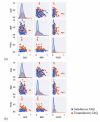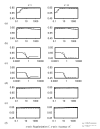Updating Indoor Air Quality (IAQ) Assessment Screening Levels with Machine Learning Models
- PMID: 35565119
- PMCID: PMC9104166
- DOI: 10.3390/ijerph19095724
Updating Indoor Air Quality (IAQ) Assessment Screening Levels with Machine Learning Models
Abstract
Indoor air quality (IAQ) standards have been evolving to improve the overall IAQ situation. To enhance the performances of IAQ screening models using surrogate parameters in identifying unsatisfactory IAQ, and to update the screening models such that they can apply to a new standard, a novel framework for the updating of screening levels, using machine learning methods, is proposed in this study. The classification models employed are Support Vector Machine (SVM) algorithm with different kernel functions (linear, polynomial, radial basis function (RBF) and sigmoid), k-Nearest Neighbors (kNN), Logistic Regression, Decision Tree (DT), Random Forest (RF) and Multilayer Perceptron Artificial Neural Network (MLP-ANN). With carefully selected model hyperparameters, the IAQ assessment made by the models achieved a mean test accuracy of 0.536-0.805 and a maximum test accuracy of 0.807-0.820, indicating that machine learning models are suitable for screening the unsatisfactory IAQ. Further to that, using the updated IAQ standard in Hong Kong as an example, the update of an IAQ screening model against a new IAQ standard was conducted by determining the relative impact ratio of the updated standard to the old standard. Relative impact ratios of 1.1-1.5 were estimated and the corresponding likelihood ratios in the updated scheme were found to be higher than expected due to the tightening of exposure levels in the updated scheme. The presented framework shows the feasibility of updating a machine learning IAQ model when a new standard is being adopted, which shall provide an ultimate method for IAQ assessment prediction that is compatible with all IAQ standards and exposure criteria.
Keywords: assessment; indoor air quality (IAQ) index; machine learning model; screening.
Conflict of interest statement
The authors declare no conflict of interest. The funders had no role in the design of the study; in the collection, analyses, or interpretation of data; in the writing of the manuscript, or in the decision to publish the results.
Figures









Similar articles
-
A Review of Artificial Neural Network Models Applied to Predict Indoor Air Quality in Schools.Int J Environ Res Public Health. 2023 Jul 25;20(15):6441. doi: 10.3390/ijerph20156441. Int J Environ Res Public Health. 2023. PMID: 37568983 Free PMC article. Review.
-
Evaluating machine learning models to classify occupants' perceptions of their indoor environment and sleep quality from indoor air quality.J Air Waste Manag Assoc. 2022 Dec;72(12):1381-1397. doi: 10.1080/10962247.2022.2105439. Epub 2022 Oct 21. J Air Waste Manag Assoc. 2022. PMID: 35939653
-
Machine learning and statistical models for predicting indoor air quality.Indoor Air. 2019 Sep;29(5):704-726. doi: 10.1111/ina.12580. Epub 2019 Jul 25. Indoor Air. 2019. PMID: 31220370 Review.
-
Do we need different machine learning algorithms for QSAR modeling? A comprehensive assessment of 16 machine learning algorithms on 14 QSAR data sets.Brief Bioinform. 2021 Jul 20;22(4):bbaa321. doi: 10.1093/bib/bbaa321. Brief Bioinform. 2021. PMID: 33313673
-
Evaluation of Indoor Air Quality Screening Strategies: A Step-Wise Approach for IAQ Screening.Int J Environ Res Public Health. 2016 Dec 14;13(12):1240. doi: 10.3390/ijerph13121240. Int J Environ Res Public Health. 2016. PMID: 27983667 Free PMC article.
Cited by
-
A Review of Artificial Neural Network Models Applied to Predict Indoor Air Quality in Schools.Int J Environ Res Public Health. 2023 Jul 25;20(15):6441. doi: 10.3390/ijerph20156441. Int J Environ Res Public Health. 2023. PMID: 37568983 Free PMC article. Review.
References
-
- Klepeis N.E., Nelson W.C., Ott W.R., Robinson J.P., Tsang A.M., Switzer P., Behar J.V., Hern S.C., Engelmann W.H. The National Human Activity Pattern Survey (NHAPS): A resource for assessing exposure to environmental pollutants. J. Expo. Sci. Environ. Epidemiol. 2011;11:231–252. doi: 10.1038/sj.jea.7500165. - DOI - PubMed
-
- Burroughs H.E., Hansen S.J. Managing Indoor Air Quality. Fairmont Press; Lilburn, GA, USA: 2001.
-
- Brown S.K. Indoor Air Quality. Australia: State of the Environment Technical Paper Series (Atmosphere) Department of the Environment, Sport and Territories; Canberra, Australia: 1997.
-
- Azuma K., Uchiyama I., Ikeda K. The regulations for indoor air pollution in Japan: A public health perspective. J. Risk Res. 2008;11:301–314. doi: 10.1080/13669870801967119. - DOI
Publication types
MeSH terms
LinkOut - more resources
Full Text Sources
Medical

